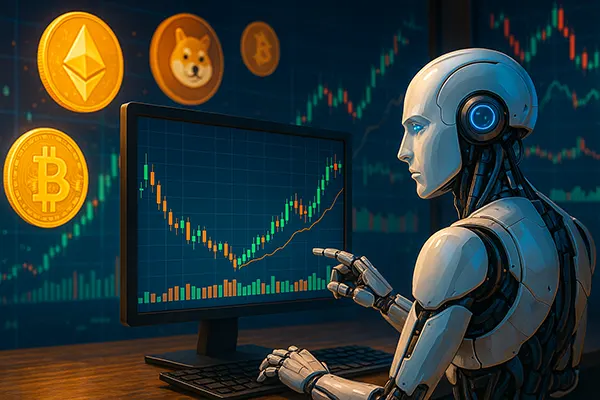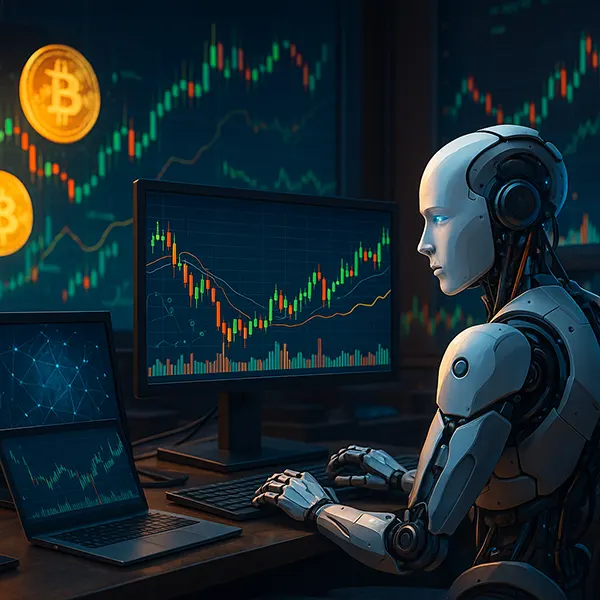
AI Trading and Crypto Markets: Does Artificial Intelligence Truly Improve Profitability?
As the cryptocurrency industry matures, traders increasingly look to artificial intelligence (AI) for a technological edge. Automated systems, machine learning models and big data analysis are no longer experimental—they have become a vital part of modern crypto trading strategies. But does AI truly enhance profitability, or is it just another trend with overhyped promises?
The Role of AI in Crypto Market Analysis
Artificial intelligence is being adopted in crypto trading for its ability to rapidly process large datasets and detect patterns invisible to human traders. Algorithms can analyse market sentiment, track price fluctuations, and execute trades in milliseconds. These tools often use machine learning to continuously improve performance based on historical and real-time data.
Quantitative hedge funds and trading bots integrate AI to maintain speed and consistency. In volatile markets like crypto, where prices can shift by double-digit percentages within hours, the speed and predictive capabilities of AI are highly valued. AI models trained on deep learning frameworks can spot emerging trends faster than traditional technical analysis methods.
Moreover, AI-powered systems don’t suffer from human emotions like fear or greed, which often drive poor decision-making. This allows for more disciplined and data-driven execution of trades, leading to improved risk management and potentially better long-term returns.
Limitations of AI in Predicting Crypto Markets
Despite its strengths, AI is not infallible. Cryptocurrency markets are affected by a range of unpredictable factors such as regulatory news, hacks, social media hype, and geopolitical events. These black swan events are difficult to model, and even the most advanced AI systems can make incorrect predictions when new variables appear suddenly.
Furthermore, AI systems can become overfitted to past data, failing to adapt to novel market conditions. If a model is too focused on historical performance, it may miss opportunities or make faulty assumptions about future price behaviour. This makes it essential to continually monitor and retrain algorithms.
There are also ethical and security concerns when using AI in financial decision-making. If a trading bot malfunctions or is manipulated, it can result in massive losses. Hence, human oversight remains critical to validate AI actions, especially in high-stakes environments like crypto finance.
Real-World Performance of AI Trading Tools
Some trading platforms and fintech firms have reported improved trading metrics after incorporating AI. Metrics such as Sharpe ratio, maximum drawdown, and win/loss ratios show enhanced performance in backtests and limited real-time environments. However, real profitability often depends on strategy design, market conditions, and the quality of training data.
According to a 2025 report by CryptoCompare, AI-enhanced crypto portfolios outperformed manual strategies by an average of 12% over a 12-month period, particularly in high-volatility altcoin markets. This suggests AI can indeed generate alpha—returns exceeding market benchmarks—under the right conditions.
Nonetheless, results are inconsistent across different bots and AI models. Some traders find AI tools useful only as assistants rather than autonomous agents. The best performance often comes from hybrid systems where human expertise and machine efficiency are combined.
Adoption by Institutional and Retail Traders
AI trading is no longer limited to Wall Street. Retail traders now have access to AI-driven bots and analytics through decentralised apps (dApps) and crypto exchanges. These tools range from simple signal generators to complex neural networks integrated into decentralised finance (DeFi) protocols.
Institutions such as BlackRock and Fidelity have also begun experimenting with AI tools for crypto asset allocation and trading. Their interest provides legitimacy to the trend, encouraging further investment and innovation in AI-driven finance.
Still, the adoption curve is steep. Many retail users lack the technical knowledge to assess or configure AI tools effectively. This raises questions about transparency, reliability, and education in AI-assisted trading ecosystems.

Future of AI in Cryptocurrency Trading
As of June 2025, AI in crypto trading continues to evolve, moving from rule-based automation toward adaptive, self-learning systems. The integration of AI with blockchain-based oracles, predictive analytics, and quantum computing may redefine how value is analysed and exchanged in digital markets.
Moreover, regulatory developments will shape how AI is deployed in crypto finance. With the European Union and the US drafting new laws on algorithmic trading and AI ethics, traders must ensure compliance while leveraging these advanced tools.
The rise of explainable AI (XAI) could improve trust by making algorithm decisions more transparent. This will be crucial for financial auditing, fraud detection, and investor confidence in AI-managed crypto funds.
Balancing Innovation with Risk Management
AI will continue to play a growing role in crypto markets, but profitability is not guaranteed. Traders and firms must balance innovation with strong risk management practices, transparent modelling, and robust oversight. AI is a powerful tool, not a magic wand.
Education is key. As access to AI grows, users must develop a deeper understanding of its mechanics and limitations. Blind trust in black-box models can lead to systemic vulnerabilities, especially in decentralised ecosystems.
Ultimately, AI can enhance decision-making and market efficiency if applied thoughtfully. But success depends on integrating AI within a broader strategy that includes human judgement, ethical standards, and continuous learning.
Popular articles
-
 Cryptocurrency Bridges: Key Risks, Major Hacks and the Future of Cr...
Cryptocurrency Bridges: Key Risks, Major Hacks and the Future of Cr...Cryptocurrency bridges have become a critical component of the modern …
-
 Risks 2025: Quantum Computers, Cryptocurrency Security and Whether ...
Risks 2025: Quantum Computers, Cryptocurrency Security and Whether ...Rapid progress in quantum technologies raises understandable concerns within the …
